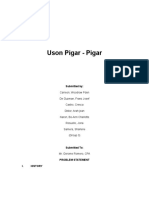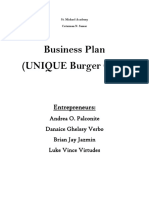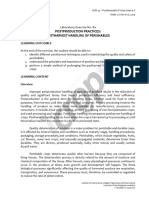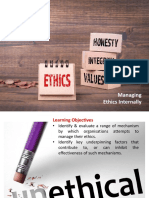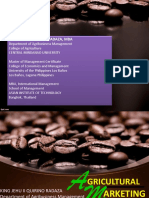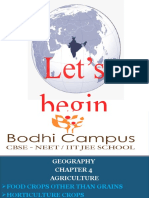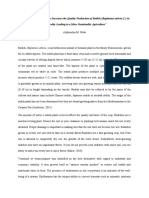The Sustainability of Food Supply at Public Market in City of Malabon During The Pandemic
The Sustainability of Food Supply at Public Market in City of Malabon During The Pandemic
Uploaded by
Marianjoy FernandezCopyright:
Available Formats
The Sustainability of Food Supply at Public Market in City of Malabon During The Pandemic
The Sustainability of Food Supply at Public Market in City of Malabon During The Pandemic
Uploaded by
Marianjoy FernandezOriginal Title
Copyright
Available Formats
Share this document
Did you find this document useful?
Is this content inappropriate?
Copyright:
Available Formats
The Sustainability of Food Supply at Public Market in City of Malabon During The Pandemic
The Sustainability of Food Supply at Public Market in City of Malabon During The Pandemic
Uploaded by
Marianjoy FernandezCopyright:
Available Formats
THE SUSTAINABILITY OF FOOD SUPPLY AT PUBLIC MARKET IN
CITY OF MALABON DURING THE PANDEMIC
A Research Proposal
Presented to the Faculty of the
Hospitality Management/Culinary Management/Tourism Management Program
STI College Caloocan
In Partial Fulfilment
of the Requirements for the Degree
Bachelor of Science in Hospitality Management
Elly Rose M. Francisco
Jasmine Derez
Jeraldine I. Burlaos
Marian Joy F. Corpuz
October. 17, 2021
RESEARCH PROPOSAL APPROVAL SHEET
This research proposal entitled: The Sustainability of Food Supply at Public Market
In City Of Malabon During The Amidst Pandemic Prepared and submitted by Elly
Rose M. Francisco; Jasmine, Derez; Jeraldine I. Burlaos; and Marian Joy F.
Corpuz, in partial fulfillment of the Bachelor of Science degree requirements in
Hospitality Management, has been examined and is recommended for acceptance and
approval.
Emmaline Cunanan
Research Adviser
Paul Timothy Clemente
Research Coordinator
Editha Mendoza
Program Head
October. 17, 2021
FT-CRD-114-00| STI College Caloocan ii
TABLE OF CONTENTS
Page
Title Page i
Approval Sheet ii
Table of Contents iii
CHAPTER 1: Introduction 1
Background of the Study
Research Questions
Significance of the Study
Scope and Limitations
CHAPTER II: Review of Related Literature
References
CHAPTER III: Theoretical Framework/Conseptual Framework
FT-CRD-114-00| STI College Caloocan iii
CHAPTER 1
INTRODUCTION
In our title research, you can read what food supply is in a pandemic, and how Public
Market in City of Malabon solve it. How they also carry or cope with such a pandemic
problem. As the COVID-19 disease spread. On 11 March 2020, the World Health
Organization (WHO) declared the rapidly spreading disease as a pandemic and called on
countries to plan preparatory and response actions in line with the Global Strategic
Preparedness and Response Plan. Every industry in the world expects to see how the
COVID-19 outbreak will affect the manufacturing industry, considerable attention has
focused on the resiliency of food supply chains in a time of crisis. Food supply chains
have needed to adjust rapidly to demand-side shocks, including panic buying and changes
in food purchasing patterns, as well as plan for any supply-side disruptions due to
potential labor shortages and disruptions to transportation and supply networks However,
the difference in the food industry from other industries is to produce products that are
essential for daily life. Everybody knows that if one factory closes, a certain number of
people who works at these factories have the potential to starve, but if processors and
distributors are infected, all people are at risk. In addition, the food industry is a very
important sector in regard to economy.
FT-CRD-114-00| STI College Caloocan 4
Background of the Study
Although the COVID-19 epidemic is primarily a public health concern, the necessary
measures enacted to contain the spread of the virus, especially the restrictions placed on
the movement of people and goods, COVID-19 has imposed shocks on all segments of
food supply chains, simultaneously affecting, food processing, deliver to other food
establishment, transport and logistics, and final demand. Not all sectors and products
have been equally affected, and different products have experienced disruptions at
different stages of the supply chain. In addition to the issues that will affect all the
Vendors at Public Market at City of Malabon, food manufacturers and their suppliers will
have additional factors to consider.
There is currently no evidence that the virus has been transmitted via food or food
packaging, but there is evidence that it can remain viable on certain surfaces for a longer
period of time. Normal food handling procedures should be sufficient to combat COVID-
19, so long as social distancing and other measures are followed.
Research Questions
How do the vendors evaluate the sustainability of food supply in their market in terms of:
1.1 Viability
1.2 Availability
1.3 Waste Management
1.4 Packaging
1.5 Product Safety
1.6 Affordability
How many percent will be lost in a food supply during Covid-19?
How many stocks will the establishment purchase in a week?
From 1-5 please rate the adaptation happened in your establishment to sustain the food
supply during pandemic.?
FT-CRD-114-00| STI College Caloocan 5
Significance of the Study
This study will be undertaken to find out how to sustain the food supply despite this
covid 19 pandemic situation.
Vendors- this research will be benefits to the vendors of public market in City of
Malabon which they can buy a different product from their supplier in low price.
Customers- this study will helps customer to find out what products they can buy
in low price, fresh and healthy food from Public Market in Malabon.
Local government unit(LGU) of Malabon- This study will helps LGUs to know
if the city of Malabon support their needs when it comes to sustain food supply in
the market during this pandemic.
Researchers- this study will help researcher to gain more idea on how to sustain
the food supply in City of Malabon. This will be the basis for their step to
maintain their future business or establishment.
Future Researchers- this study will help students to understand the importance
of sustainability food supply in the economic situation.
Objectives
1.To know how to sustain the food supply in public market at City of Malabon.
2. To identify the factors that affect the sustainability food supply in Public Market at
City of Malabon during pandemic.
FT-CRD-114-00| STI College Caloocan 6
3. To understand the purpose of sustainability food supply at City of Malabon.
Scope and Limitations
This study focuses on sustainability of food supply in public market at the Ciry of
Malabon during the amidst pandemic.
We use quantitative research and include set of questions for this topic. We also use
survey to record the feedback from our selective respondents.
There are fifty (50) respondents of this study coming from public market vendor City of
Malabon.
The researcher's carried out various activities that included phases of the study:
formulating a thesis proposal for the month of September; approving of thesis proposal in
October; data collection for the chapter 3 down to synthesis in the month of November
and December; presentation, analysis, interpretation of research data and final defense for
the month of january.
CHAPTER II
REVIEW OF RELATED LITERATURE
According to (FAO, 2020), The Food supply chain can be divided into five stages,
including agricultural production, postharvest handling, processing,
distribution/retail/service, and consumption. Two systems are being used in the food
supply chain regarding food quality and safety. The First one is based on regulations and
laws that use mandatory standards which are inspected by state agencies. The Second one
is relying on voluntary standards which are defined by market laws or international
associations. Therefore, the supply chain is significantly affected as a result of the
absence of local or migrant workers due to sickness or travel restrictions imposed by
lockdown. It also weakens not only production abilities for others, but also their own
food safety, in cases where the disease directly affects their health or movement .
Especially, labor shortage due to COVID-19 crisis caused severe disruptions in some
sectors such as livestock production, horticulture, planting, harvesting, and crop
processing which are relatively labor intensive (Stephens et al., 2020). However, shortage
of farmworkers was a major issue well before the COVID-19 outbreak, too (Richards and
Rickard, 2020). The COVID-19 pandemic will continue to heavily affect seafood
markets, particularly fresh products and popular restaurant species this year. On the
supply side, fishing fleets are laying idle and aquaculture producers have drastically
reduced stocking targets.
The pandemic is set to severely hit, in particular, global shrimp and salmon production.
In India, for example, farmed shrimp production is expected to fall by 30-40 percent.
Also, worldwide demand for both fresh and frozen shrimp is declining significantly,
whilst demand for salmon is expected to drop by at least by 15 percent in 2020. Retail
sales, in particular, of fresh salmon and trout have fallen greatly, and this will not recover
FT-CRD-114-00| STI College Caloocan 7
for some time. Overall, food markets will face many more months of uncertainty due to
COVID-19, but the agri-food sector is likely to show more resilience to the pandemic
crisis than other sectors.
As the COVID-19 pandemic of 2020 unfolds, considerable attention has focused on the
resiliency of food supply chains in a time of crisis. Food supply chains have needed to
adjust rapidly to demand-side shocks, including panic buying and changes in food
purchasing patterns, as well as plan for any supply-side disruptions due to potential labor
shortages and disruptions to transportation and supply networks. This paper examines the
challenges facing food supply chains in Canada (and elsewhere) during the current crisis
and offers thoughts on policy and industry strategies to enhance food supply chain
resilience. A second reason for additional pressure on the food retailing sector has been
the closure of restaurants, cafés, bars, and hotels and public market with many citizens
working from home. It is estimated that just over one-third of food expenditures. For the
most part, the demand spike from panic buying behaviors is likely to be a short-run
problem. Longer-run demand-driven effects on food supply chains will arise from a fall
in consumer incomes, with overall demand impacts as well as shifts across product
categories. For example, we can expect consumers to become more price sensitive and
the demand for income elastic products to decline more sharply as consumers substitute
away from more expensive items. This can be expected to influence retailer buyer
behavior with respect to product category management and contractual relationships with
suppliers. In the event of a severe economic downturn and decline in demand, retailers
may squeeze supply chains for cost efficiencies. As these are typically low-margin
businesses, this will create challenges for many food processors and suppliers. Small food
retailers with less bargaining power relative to the larger food retail chains may also face
challenges.
If the availability and popularity of online grocery delivery increases during the COVID-
19 pandemic, what happens once the pandemic is behind us? Do consumers return to
previous methods of grocery shopping or could this event prove to be a catalyst in the
sustained adoption of online grocery delivery?
According to Malabon city government, has assured its constituents of nutritious food on
their table during the extended imposition of the Modified Enhanced Community
Quarantine (MECQ) in the National Capital Region.
The program ensuring nutritious and sufficient food to Malabon residents was led by
Councilor Jose Lorenzo “Enzo” Oreta.
Prioritizing the food security program for his fellow Malabonians is under the councilor’s
“Kalinga sa Kalusugan” Program. “With the many emerging variants of COVID-19, it is
imperative to boost our health, and one way of doing this is eating nutritious foods,” said
Oreta.
To attain this goal, Oreta has been leading the drive of giving vegetables, eggs, and other
safe and healthy foods to their “kaasenso.”
FT-CRD-114-00| STI College Caloocan 8
The “Kalinga sa Kalusugan” package contains nutritious foods such as rice, vegetables,
and eggs, among the many, which are also sourced out from farmers whose means of
living were also affected by the pandemic.
Crisanta Lara Junio, a Malabonian beneficiary, expressed her gratitude to the program,
noting that it has greatly helped her family.
“We are thankful that the City Government through Mayor Lenlen and Councilor Enzo
has initiated this program because we don’t have to eat mostly canned goods as with the
usual relief goods. Nutritious food like vegetables help in nourishing our children
especially in the fight against COVID-19,” she added. As the poor lose their jobs amid
the coronavirus pandemic, they are also being crushed by rising prices of goods.
According to Data from the Philippine Statistics Authority (PSA) showed that inflation
for the bottom 30% households have been higher than the country's headline inflation
since the lockdowns started in March. Food prices in Manila rose, with meat soaring
16.3%. Fish and rice prices also went up, while vegetable prices started to show signs of
increases. Manila and nearby areas in Luzon are currently experiencing higher pork
prices, as the pandemic, as well as African swine fever, affected supply.
Pork prices have soared by almost 70% since January and pork now costs as much as
beef, data from the Department of Agriculture showed. Food markets continue to deal
with unprecedented and simultaneous shocks to supply and demand that impacted the
entire supply chain and caused significant shifts in demand patterns. On the supply side,
there have been temporary closures of a number of meatpacking plants and a slower pace
of slaughter at others due to COVID-19, which led to tightening supplies of some meat
products over the past few weeks. The tightening meat supply and food price increases
resulted from demand changes and temporary disruptions in supply. They don’t imply
long-term food shortages or a fundamental breakdown in the supply chain. Meat supplies
have begun to recover as plants have returned to production and are adapting to COVID-
19 guidelines for worker safety, and prices of some food products are starting to come
down.
According to Investigation of Food Supply Chain Sustainability Performance for
Turkey's Food Sector, Increasing product demands, environmental aspects, and
overpopulation have an impact on the sustainability of a supply chain, especially in the
food sector. In a food supply chain from production to consumption, there are many
parameters (resources, packaging, waste management, etc.) that need to be taken into
account for sustainability. The aim of this study is to determine the parameters affecting
sustainable food supply chain management for the food sector and to measure the
performance of the parameters along the supply chain. In this study, several performance
indices and sub-criteria are defined by reviewing the indices previously discussed in the
literature and accounting for expert opinions on the sustainable food supply chain.
Customer satisfaction, resource utilization, product safety, innovation, reliability,
company information, packaging, and waste management are defined as the parameters,
as these are dimensions that should be improved in sustainable food supply chain
management. The performance score for each dimension is calculated via Structural
Equation Modeling and the Analytic Hierarchy Process. Customer satisfaction is
calculated to have the highest performance, with a score of 86.23% in sustainable food
FT-CRD-114-00| STI College Caloocan 9
supply chain management performance evaluation, followed by the product safety
dimension, at 84.65%, while the performance index score of the reliability dimension is
82.97%, that of the packaging dimension is 78.81%, that of the company information
dimension is 75.10%, that of resource utilization is 71.41%, and that of the waste
management dimension is 67.83%. The sustainable food supply chain performance
evaluation for the food sector in Turkey indicates that it has an overall performance of
79.7%. The results of this study include feedbacks on parameters in the food chain from
agriculture to consumers.
According to (Koç, et al,. 2015), In this chain, which starts with agriculture and goes to
the consumer, taking into account recycling, the important factors for sustainable food
supply chain management are sustainable resource utilization (water, energy, etc.),
sustainable soil management, sustainable packaging, waste management, sustainability
R&D projects, product safety, sustainable consumption, and customer satisfaction. Solid
and water waste are serious threats to the food sector, especially in waste management.
The food sector should draw attention to water consumption, as both the agricultural raw
material it demands and the amount of water used in the process can be excessive. Food
producers should therefore use water, one of the most important natural resources,
effectively, and ensure the recycling of waste.
Natural resources and energy are used in many stages, from food production to the
preservation of freshness. Furthermore, most of the greenhouse gas emissions of the food
sector are related to energy usage. The reduction of fossil fuel usage is important in every
area, from the production of the product to its transportation. The efficient use of energy
resources such as electricity, coal, and oil and the use of renewable energy are also
desirable in the sustainable supply chain.
Food is the area of commerce that uses the most packaging. Food companies can ensure
sustainability by minimizing the use of materials and energy in packaging, reducing
packaging weights, and recycling. In this regard, food companies should cooperate with
packaging manufacturers and support R&D activities. Solid waste consisting of
packaging at the consumption stage should not harm the natural world and should not
endanger human health (Koç, 2015). At the same time, food companies should cooperate
with their suppliers on transport and collaborate with suppliers to create a sustainable
chain.
FT-CRD-114-00| STI College Caloocan 10
CHAPTER III
THEORETICAL FRAMEWORK/CONCEPTUAL FRAMEWORK
This study is supported by the theory of sustainable food supply chain management
(SFSCM), to learn the working process within the food supply chain. SFSCM includes
the use of agricultural products as raw materials, optimum resource utilization during the
processing of the product in the production line, packaging, and delivery, and
sustainability studies are carried all along the chain. It is important to consider and to
evaluate each criterion (resource utilization, packaging, waste management, etc.) in
supply chain sustainability. Each of the criteria should be handled to make the chain
sustainable economically, environmentally, and socially (Koç, 2015).
While addressing the issue of SFSCM, many criteria from resource utilization to waste
management, packaging, and supplier collaboration should be taken into consideration.
As shown in Figure 1, in this chain, which starts with agriculture and goes to the
consumer, taking into account recycling, the important factors for sustainable food supply
chain management are sustainable resource utilization (water, energy, etc.), sustainable
soil management, sustainable packaging, waste management, sustainability R&D
projects, product safety, sustainable consumption, and customer satisfaction.
Sustainable food supply chain management emerges by considering each of these factors
as economic, social, and environmental (Figure 1).
ADAPTED DIMENSION OF
DIMENSION OF SUSTAINABLE FOOD SUPPLY
SUSTAINABLE FOOD CHAIN MANAGEMENT
SUPPLY CHAIN
MANAGEMENT VIABILITY
AGRICULTURE AVAILABILITY
WASTE MANAGEMENT
SUPPLIER
CUSTOMER
PACKAGING SATISFACTION
PRODUCTION
PRODUCT SAFETY
TRANSPORT
AFFORDABILITY
CONSUMER
Figure 1. Theoretical Paradigm. Adapted Sustanable Food Supply Chain Management
by Koç, et al., (2015)
FT-CRD-114-00| STI College Caloocan 11
Agricultural
CONCEPTUAL FRAMEWORK
INPUT PROCESS OUTPUT
• Availability of In survey form will
Food Supply During determine the vendors
Conducting survey improvement to sustain
Pandemic to the vendors and food supply during
consumers pandemic
• Food Production Questionnaires
Activities Adaptation in situation
Analysis of data of vendors and
Information in Food consumers to supply
• Produce Wastes Supply and Demand and demand in amidst
• Affordability of pandemi
Food Product
FT-CRD-114-00| STI College Caloocan 12
REFERENCES
https://onlinelibrary.wiley.com/doi/10.1111/cjag.12237
https://academic.oup.com/fqs/article/4/4/167/5896496
http://www.fao.org/2019-ncov/q-and-a/impact-on-food-and-agriculture/en/
https://link.springer.com/chapter/10.1007/978-3-030-13958-2_4
FT-CRD-114-00 | STI College <School Name> 13
You might also like
- (MTSERCH) Final PaperDocument23 pages(MTSERCH) Final PaperCarlos Johann LuNo ratings yet
- Feasibility Study of Fruity PutoDocument14 pagesFeasibility Study of Fruity PutoAelirab AnnaNo ratings yet
- Table of ContentsDocument17 pagesTable of ContentsJaycel Babe Verances0% (1)
- IPMC Case Analysis - VailocesDocument6 pagesIPMC Case Analysis - VailocesEmma VailocesNo ratings yet
- TleDocument4 pagesTleRhoda BurgosNo ratings yet
- A Comparative Study On Amul India and Mother Dairy in LucknowDocument78 pagesA Comparative Study On Amul India and Mother Dairy in LucknowShivanshu Verma100% (1)
- Thesis Chapter 1-TrueDocument16 pagesThesis Chapter 1-Truerobi2551No ratings yet
- PR FileDocument44 pagesPR FileKerr RealNo ratings yet
- Feasibility Study of Establishing A Coconut Lumber Processing Plant in The Pomio District of East Britain2Document19 pagesFeasibility Study of Establishing A Coconut Lumber Processing Plant in The Pomio District of East Britain2rooker77No ratings yet
- Entrepreneurial optionsPPT4Document45 pagesEntrepreneurial optionsPPT4Trixie Ann MenesesNo ratings yet
- Group 3 11 Abm 16 Mini Marketing PlanDocument55 pagesGroup 3 11 Abm 16 Mini Marketing PlanJoaquin Niccolas TulabutNo ratings yet
- Pasalubong RepublicDocument31 pagesPasalubong RepublicShara ValleserNo ratings yet
- Asi Csr07 FinalDocument40 pagesAsi Csr07 FinalMarygrace C. NovedaNo ratings yet
- HAY Natural Massage Spa "A Feasibility Study On Establishing Massage Spa in Mandurriao, Iloilo City"Document4 pagesHAY Natural Massage Spa "A Feasibility Study On Establishing Massage Spa in Mandurriao, Iloilo City"Budoy BudoyNo ratings yet
- For Final Paper FsDocument50 pagesFor Final Paper Fsgaymariecanumay6No ratings yet
- M&D Sweet Potato (Final)Document44 pagesM&D Sweet Potato (Final)tainsilfordNo ratings yet
- 1Document26 pages1Cresca Cuello CastroNo ratings yet
- Marketing Plan Lechon 1Document23 pagesMarketing Plan Lechon 1Mariah SoternoNo ratings yet
- QC Actual Population 2015 and Projection 2025Document7 pagesQC Actual Population 2015 and Projection 2025Gerald LomocsoNo ratings yet
- FEASIBILITY - STUDY v1Document24 pagesFEASIBILITY - STUDY v1MaeNo ratings yet
- The OneDocument51 pagesThe OneDann SolisNo ratings yet
- This Study Resource Was: Background of The StudyDocument8 pagesThis Study Resource Was: Background of The StudyAlipaspas, Jill AnneNo ratings yet
- Perception of The Custumer Toward To The Food Restaurant To Be Built in Boac MarinduqueDocument18 pagesPerception of The Custumer Toward To The Food Restaurant To Be Built in Boac MarinduqueIshigami SenkuNo ratings yet
- Shawarma 2Document28 pagesShawarma 2Billy PestañoNo ratings yet
- Chapter IDocument12 pagesChapter ICharm EspinolaNo ratings yet
- Business Plan (UNIQUE Burger Café) : EntrepreneursDocument31 pagesBusiness Plan (UNIQUE Burger Café) : EntrepreneursAndrea PalconiteNo ratings yet
- Mang Inasal: Submitted byDocument43 pagesMang Inasal: Submitted byLeonardo Jr SaldivarNo ratings yet
- Conceptual FrameworkDocument1 pageConceptual FrameworkRandy DonatoNo ratings yet
- L' Pacioli Food Hub: Activity in TechnopreneurshipDocument9 pagesL' Pacioli Food Hub: Activity in Technopreneurshipfrancis dungca100% (1)
- Survey 1 TamanajudDocument5 pagesSurvey 1 TamanajudReymark O. CampasasNo ratings yet
- Effects of Geographical Area To The Sales of Local Snackhouses in Liliw, LagunaDocument130 pagesEffects of Geographical Area To The Sales of Local Snackhouses in Liliw, LagunaAlgem BacardiNo ratings yet
- Marketing AspectDocument17 pagesMarketing AspectPrincess SilvaNo ratings yet
- 3 - Technical AspectDocument17 pages3 - Technical AspectNathalie PadillaNo ratings yet
- Module 1 Overview On AgribusinessDocument6 pagesModule 1 Overview On AgribusinessNor Shailanie NalamNo ratings yet
- Midterm Activity 1: (For Asynchronous) : I. Multiple ChoiceDocument6 pagesMidterm Activity 1: (For Asynchronous) : I. Multiple ChoiceArven FrancoNo ratings yet
- Credit Card CollectionDocument1 pageCredit Card CollectionhananNo ratings yet
- Exercise 8a Learning Module - 1st Semester AY 2023-2024Document16 pagesExercise 8a Learning Module - 1st Semester AY 2023-2024Aria MoonNo ratings yet
- Managing Ethic InternallyDocument35 pagesManaging Ethic InternallyBudy s Raharja100% (3)
- Final Revised 2Document100 pagesFinal Revised 2glow beeNo ratings yet
- Case Study No. 3: Clean Energy Is A Dirty BusinessDocument20 pagesCase Study No. 3: Clean Energy Is A Dirty BusinessKarem PalmesNo ratings yet
- Calamansi MarmaladeDocument8 pagesCalamansi MarmaladeBog�albal MaybelleNo ratings yet
- Chapter 1-3 Apbp Manufacturing CompanyDocument38 pagesChapter 1-3 Apbp Manufacturing CompanySweathzel Cabarrubias GutierrezNo ratings yet
- Feasibility Study Chapter 1 To 3Document14 pagesFeasibility Study Chapter 1 To 3Neil Jon Huit100% (1)
- Case Study-PoultryDocument7 pagesCase Study-PoultryParv PandyaNo ratings yet
- MANA 01BC - PRINCIPLES OF MANAGEMENT AND ORGANIZATION - StandardDocument93 pagesMANA 01BC - PRINCIPLES OF MANAGEMENT AND ORGANIZATION - StandardSkyler FaithNo ratings yet
- Mang InasaaaaaaaaaaalDocument4 pagesMang InasaaaaaaaaaaalEdselle PatriarcaNo ratings yet
- 1.1 Basic of Agricultural MarketingDocument25 pages1.1 Basic of Agricultural MarketingOliver TalipNo ratings yet
- Feasibility Study On Tuna LongganisaDocument5 pagesFeasibility Study On Tuna LongganisaSammie BacleonNo ratings yet
- Chapter 3 MARKET ASPECT 3.1 General Market Description 3.1.2 ClinicalDocument3 pagesChapter 3 MARKET ASPECT 3.1 General Market Description 3.1.2 Clinicalgotguests67% (6)
- Feasibility StudyDocument65 pagesFeasibility Studyi21-0467-284No ratings yet
- Project Feasibility Writing GuideDocument24 pagesProject Feasibility Writing Guideمحمداویس کیانیNo ratings yet
- Operations Plan: University of Rizal System - BinangonanDocument3 pagesOperations Plan: University of Rizal System - BinangonanJose John VocalNo ratings yet
- The Original Buko PieDocument3 pagesThe Original Buko Pieaccounting prob100% (2)
- Feasibility Study Example 32Document6 pagesFeasibility Study Example 32alnahary1No ratings yet
- Bitter Gourd For A Better Health Project ProposalDocument23 pagesBitter Gourd For A Better Health Project Proposaleiram farinas100% (1)
- Feasibility Study of Wais Laundry On The Go in Barangay Centrala Surallah, South CotabatoDocument36 pagesFeasibility Study of Wais Laundry On The Go in Barangay Centrala Surallah, South CotabatoXybele yleine CastroNo ratings yet
- CHAPTER II - MRL Rice Mill Problem StatementDocument1 pageCHAPTER II - MRL Rice Mill Problem StatementLovely Rose Cobar100% (1)
- Final Feasibility Study 1 1Document69 pagesFinal Feasibility Study 1 1Donna Lee Bug-atanNo ratings yet
- CHPTER2Document25 pagesCHPTER2JOEFRAN ENRIQUEZNo ratings yet
- ConclusionDocument3 pagesConclusionChao KimNo ratings yet
- Harvesting Trust : Building Confidence in Food Safety PracticesFrom EverandHarvesting Trust : Building Confidence in Food Safety PracticesNo ratings yet
- ViabilityDocument1 pageViabilityMarianjoy FernandezNo ratings yet
- Executive Summary1Document3 pagesExecutive Summary1Marianjoy FernandezNo ratings yet
- INTRODUCTIONDocument2 pagesINTRODUCTIONMarianjoy FernandezNo ratings yet
- (Application Form) San Miguel Foods Community Selling Program - Application FormDocument2 pages(Application Form) San Miguel Foods Community Selling Program - Application FormMarianjoy FernandezNo ratings yet
- EuthenicsDocument1 pageEuthenicsMarianjoy FernandezNo ratings yet
- Palawan: Decree 1596 Dated June 11, 1978Document9 pagesPalawan: Decree 1596 Dated June 11, 1978Rhoda Grace Agustin IlisanNo ratings yet
- Vertical FarmingDocument43 pagesVertical Farmingyesbank45No ratings yet
- Dog-Phenotypic CharacterizationDocument11 pagesDog-Phenotypic Characterizationpurn prakashNo ratings yet
- Food Crops Other Than Grains PPTDocument39 pagesFood Crops Other Than Grains PPTAfrina Asmi MINo ratings yet
- Potensi Hijauan Di Perkebunan Kelapa Sawit Sebagai Pakan Sapi Potong Di Kabupaten Kutai KartanegaraDocument2 pagesPotensi Hijauan Di Perkebunan Kelapa Sawit Sebagai Pakan Sapi Potong Di Kabupaten Kutai KartanegaraFriskilia RenmaurNo ratings yet
- Tle 9 SemiDocument4 pagesTle 9 Semiericahaguimet15No ratings yet
- Bommel Et Al. - 2016 - Livelihoods of Local Communities in An Amazonian Floodplain Coping With Global Changes From Role-Playing Games TDocument11 pagesBommel Et Al. - 2016 - Livelihoods of Local Communities in An Amazonian Floodplain Coping With Global Changes From Role-Playing Games TbinhokrausNo ratings yet
- Tree Planting Guidelines Bs8545Document90 pagesTree Planting Guidelines Bs8545cheekymonkey.cp100% (1)
- West Africans Built in Stone by 1100 BC. One of The Oldest Known Historical Sites - The African HistoryDocument8 pagesWest Africans Built in Stone by 1100 BC. One of The Oldest Known Historical Sites - The African HistoryDigital NomadNo ratings yet
- GlowCorp CaseDocument25 pagesGlowCorp CaseJAMES WILLIAM BALAONo ratings yet
- Perspective in Environmental Studies, 2ed. (PDFDrive)Document296 pagesPerspective in Environmental Studies, 2ed. (PDFDrive)ShanmukhaNo ratings yet
- Agriculture Technology: Malaysia International ExhibitionDocument4 pagesAgriculture Technology: Malaysia International ExhibitionRyan RiyyanNo ratings yet
- Farm Tools and Equipment PreciousDocument4 pagesFarm Tools and Equipment PreciousREMY SABIONo ratings yet
- Phenotypic Evaluation and Characterization of F2 SquashDocument17 pagesPhenotypic Evaluation and Characterization of F2 SquashSaheden SalilawanNo ratings yet
- Nama: Kayla Sheila Syakira NPM: 150510210250 Prodi: Agroteknologi Kelas: KBLI EDocument4 pagesNama: Kayla Sheila Syakira NPM: 150510210250 Prodi: Agroteknologi Kelas: KBLI EKAYLA SHEILA SYAKIRANo ratings yet
- ABEN 2427: ABE and Related Laws, Specifications, Contracts & Professional EthicsDocument10 pagesABEN 2427: ABE and Related Laws, Specifications, Contracts & Professional EthicsJhayziel OrpianoNo ratings yet
- Treasure Chest Workbook Class 10thDocument14 pagesTreasure Chest Workbook Class 10thAradhana ShuklaNo ratings yet
- VCS Program Definitions v4.2Document23 pagesVCS Program Definitions v4.2djainuddin rajabNo ratings yet
- Cotton Fiber Development and Processing BookDocument104 pagesCotton Fiber Development and Processing BookkhaydarovamalikaxonNo ratings yet
- Scope of Drip Irrigation For Vegetable Production in India: AgricultureDocument3 pagesScope of Drip Irrigation For Vegetable Production in India: AgricultureHemant TilgamNo ratings yet
- UNDP NITI AAYOG Best Practices in Social Sector CompendiumDocument224 pagesUNDP NITI AAYOG Best Practices in Social Sector CompendiumParwez AkhtarNo ratings yet
- Conceptpaper Radish AlphinelynSildaDocument6 pagesConceptpaper Radish AlphinelynSildaApril Rose Silda MangyanNo ratings yet
- First Summative Test in Tle (Agriculture)Document4 pagesFirst Summative Test in Tle (Agriculture)Victoria Badillo100% (3)
- Agribusiness Review Material For MidtermDocument2 pagesAgribusiness Review Material For Midtermjasmaeramos2No ratings yet
- Summary of Related RA's To ABEDocument3 pagesSummary of Related RA's To ABEBill GuevarraNo ratings yet
- Recent Studies On The Use of Lasers in AgricultureDocument16 pagesRecent Studies On The Use of Lasers in AgricultureCeren KılıçNo ratings yet
- Banana IPM CultivationDocument7 pagesBanana IPM CultivationFarmsons AgriNo ratings yet
- Food QulityDocument82 pagesFood QulityranjanantaraNo ratings yet
- Accepted Conferences by Subject Report Aug 18Document71 pagesAccepted Conferences by Subject Report Aug 18KarinHanazonoNo ratings yet
















